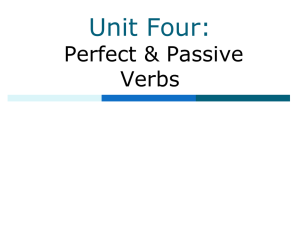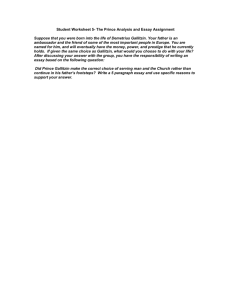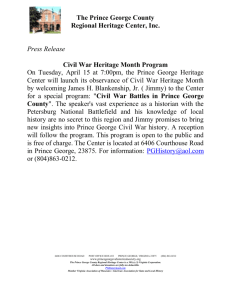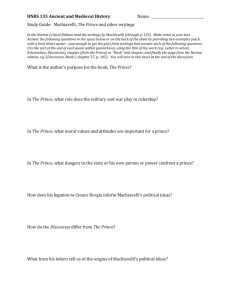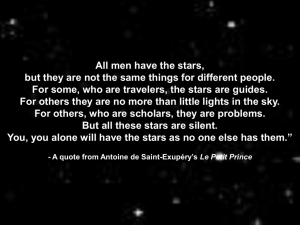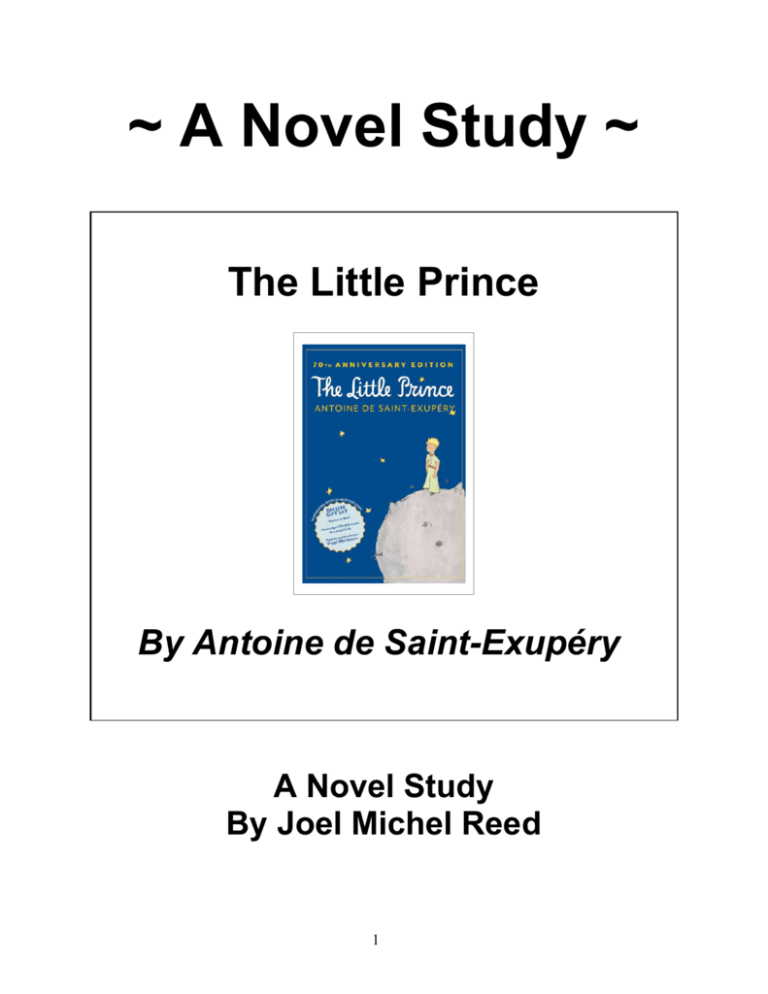
~ A Novel Study ~
The Little Prince
By Antoine de Saint-Exupéry
A Novel Study
By Joel Michel Reed
1
The Little Prince
By Antoine de Saint-Exupéry
Table of Contents
Suggestions and Expectations ..……………………………………….
3
List of Skills ….……………………………….…………………………..
4
Synopsis / Author Biography …..…………………………………......
5
Student Checklist ………………………………………………………..
6
Reproducible Student Booklet ..………………………………………..
7
Answer Key ...……………………………………………………………...
49
About the author: Joel Reed has over 40 published novel studies and is the coauthor of three novels. For more information on his work and literature, please visit
the websites www.reedpublications.org and www.novelstudies.org.
Copyright © 2015 Joel Reed
All rights reserved by author.
Permission to copy for single classroom use only.
Electronic distribution limited to single classroom use only.
Not for public display.
2
The Little Prince
By Antoine de Saint-Exupéry
Suggestions and Expectations
This curriculum unit can be used in a variety of ways. Each chapter of the novel study focuses on
four or five chapters (sections) of The Little Prince and is comprised of five of the following
different activities:
•
•
•
•
•
Before You Read
Vocabulary Building
Comprehension Questions
Language Activities
Extension Activities
Links with the Common Core Standards (U.S.)
Many of the activities in this unit are supported by the Common Core Standards. For
instance the Reading Standards for Literature, Grade 5, makes reference to
a) determining the meaning of words and phrases. . . including figurative language;
b) explaining how a series of chapters fits together to provide the overall structure;
c) compare and contrast two characters;
d) determine how characters … respond to challenges;
e) drawing inferences from the text;
f) determining a theme of a story . . . and many others.
A principal expectation of the unit is that students will develop their skills in reading, writing,
listening and oral communication, as well as in reasoning and critical thinking. Students will also
be expected to provide clear answers to questions and well-constructed explanations. It is critical
as well that students be able to relate events and the feelings of characters to their own lives and
experiences and describe their own interpretation of a particular passage.
A strength of the unit is that students can work on the activities at their own pace. Every activity
need not be completed by all students. A portfolio cover is included (p.7) so that students may
organize their work and keep it all in one place. A Student Checklist is also included (p.6) so
that a record of completed work may be recorded.
Additional icons provided by http://www.iconka.com and http://artdesigner.lv
3
The Little Prince
By Antoine de Saint-Exupéry
List of Skills
Vocabulary Development
1. Locating descriptive words / phrases
2. Listing synonyms/homonyms
3. Identifying / creating alliteration
4. Use of capitals and punctuation
5. Identify foreshadowing.
6. Identify personification
7.
8.
9.
10.
11.
12.
Use of singular / plural nouns
Listing compound words
Identifying parts of speech
Identifying syllables
Identify/create similes
Identify anagrams
Setting Activities
1. Summarize the details of a setting
Plot Activities
1. Complete a time line of events
4. Complete a story pyramid
5. Identify the climax of the novel.
2. Identify conflict in the story
3. Complete Five W's Chart
Character Activities
1. Determine character traits
2. Identify the protagonist
3. Relating personal experiences
4. Compare two characters
Creative and Critical Thinking
1.
2.
3.
4.
5.
Research projects
Write a newspaper story
Participate in a talk show
Compare the book and movie.
Conduct an interview.
6.
7.
8.
9.
10.
Write a description of personal feelings
Write a book review
Complete an Observation Sheet
Complete a KWS Chart
Write a poem and a short story
Art Activities
1. A Storyboard
2. Create a collage
4. Design a cover for the novel
5. Create a comic strip
4
The Little Prince
By Antoine de Saint-Exupéry
Synopsis
A pilot stranded in the desert awakes one morning to see, standing before him, the most
extraordinary little fellow. “Please,” asks the stranger, “draw me a sheep.” And the pilot realizes
that when life's events are too difficult to understand, there is no choice but to succumb to their
mysteries. He pulls out a pencil and a paper . . . And thus begins this wise and enchanting fable
that, in teaching the secret of what is really important in life, has changed forever the world for
its readers. (Publisher – A Harvest Book Harcourt, Inc.)
A complete synopsis and other helpful reviews can be found on the following website:
https://en.wikipedia.org/wiki/The_Little_Prince
Author Biography
Antoine de Saint-Exupéry
Antoine de Saint-Exupéry, officially Antoine Marie Jean-Baptiste
Roger, comte de Saint Exupéry (29 June 1900 – 31 July 1944) was
a French aristocrat, writer, poet, and pioneering aviator. He became
a laureate of several of France's highest literary awards and also won
the U.S. National Book Award. He is best remembered for his novella
The Little Prince (Le Petit Prince) and for his lyrical aviation writings,
including Wind, Sand and Stars and Night Flight.
Saint-Exupéry was a commercial pilot before World War II, working
airmail routes in Europe, Africa and South America. At the outbreak
of war, he joined the French Air Force, flying reconnaissance missions
until France's armistice with Germany in 1940. After being demobilized from the French
Air Force, he traveled to the United States to persuade its government to enter the war
against Nazi Germany. Following a 27-month hiatus in North America, during which he
wrote three of his most important works, he joined the Free French Air Force in North
Africa, although he was far past the maximum age for such pilots and in declining health.
He disappeared over the Mediterranean on his last assigned reconnaissance mission in
July 1944, and is believed to have died at that time. (Courtesy of Wikipedia)
5
The Little Prince
By Antoine de Saint-Exupéry
Student Checklist
Student Name:
Assignment
Grade/Level
6
Comments
The Little Prince
By Antoine de Saint-Exupéry
Name:
7
The Little Prince
By Antoine de Saint-Exupery
Chapters 1-4
Before you read the chapter:
Briefly predict what you believe the plot-line of The Little Prince will be about.
Vocabulary:
Choose a word from the list that means the same or nearly the same as the underlined word(s).
exclusion
friendship
exceptional
intentional
sensible
fashioned
likeness
wearing
fascinated
presentation
surprised
seemingly
1
Grown-ups never understand anything by themselves, and it is
exhausting for children to have to make explanations over and over.
2
My grown-up was glad to know such a reasonable person.
3
I saw an extraordinary little fellow staring back at me very seriously.
4
I was astounded to hear the little fellow answer.
5
That's how I made the acquaintance of the little prince.
6
You can imagine how intrigued I was by this hint about 'other plants'.
7
The astronomer repeated his demonstration in 1920, wearing a very
elegant suit. And this time everyone believed him.
8
One drawing works, and the next no longer bears any resemblance.
8
Questions
1. What strange image did the narrator see in a book entitled True Stories From Nature.
2. What career did the narrator give up in order to become a pilot?
3. Briefly describe the experiment the narrator used on those who seemed 'clear-sighted'.
4. Why did the little prince reject the narrator's first three drawings of the sheep?
First Sheep
Second Sheep
Third Sheep
b. What did the narrator end up drawing for the little prince as a result?
5. What do you think the narrator meant when he made the following statement:
“On making his discovery, the astronomer has presented it to the International
Astronomical Congress, in a great demonstration. But he was in Turkish costume, and so
nobody would believe what he said. Grown-ups are like that ...”
9
Language Activity
A.
Many authors enjoy using alliteration – a literary device where the author
repeats the same sound at the beginning of several words. Here's an example of an
alliteration: “. . . screaming, shrieking, shouting, screeching about something scary."
Using your imagination, create your own examples of alliteration from the following
topics. Each example must contain a minimum of three words.
The sounds of an airplane.
The appearance of a desert.
One from your own
imagination.
B.
Find nine singular nouns in these chapters and write the plural of each noun in the
columns below. Careful – you may wish to consult a dictionary for some of these words.
Singular Noun
Plural Noun
Child
Children
10
C. Homonyms
Homonyms are words which sound the same but have different meanings. An example is seed
and cede. These chapters feature words which are examples of homonyms. In the chart below,
create sentences which show the meaning of each set of homonyms.
Example 1
Homonyms
Sentence
1. Gait
2. Gate
Example 2
Homonyms
Sentence
1. Plain
2. Plane
D. Find ten words in Chapters 1 - 4 that being with the letter 'L' and have no less than
six characters. Once you have completed your list, arrange them in alphabetical order.
Words
Alphabetical Order
11
E. The Eight Parts of Speech
Find at least two examples of each of the eight parts of speech from these chapters and
list them in the appropriate section of the chart below.
Interjections
Nouns
Pronouns
Conjunctions
Prepositions
Adjectives
Adverbs
Verbs
12
Extension Activity
Storyboard
A storyboard is a series of pictures that tell about an important event in a story. A
storyboard can tell the story of only one scene – or the entire novel.
Complete the storyboard below illustrating the events described in the
first four chapters of The Little Prince. You may wish to practice your
drawings on a separate piece of paper.
1
2
3
4
5
6
13



